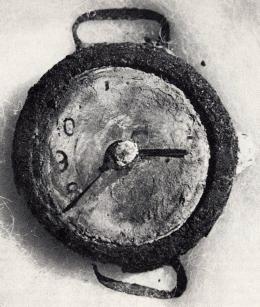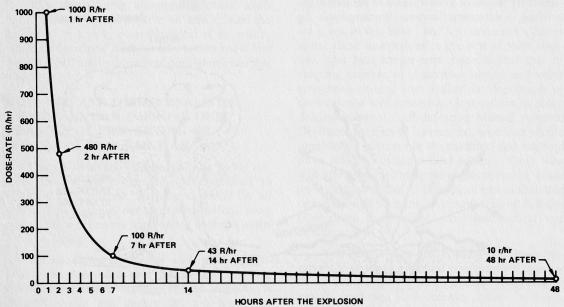| o |
| Decay
of the dose rate from fallout. |
o

Hiroshima, 6 August 1945, 08.15 hours.
Other
effects of nuclear explosions.
Firestorms and Conflagrations - Fires of large proportions
due to nuclear explosions can be of two types: firestorms,
in which strong inrushing winds give origin to extremely high temperatures
and at the same time prevent the flames to expand outwards while increasing
their intensity with the addition of oxygen, or conflagrations in
which the intense and uncontrolled flames expand outward. Firestorms
were caused during World War two at Dresden (it was almost totally
destroyed by British air raids in 1945), Hamburg, Tokyo, and Hiroshima.
The great fires due to the earthquake in San Francisco with an emission
of energy calculated as equivalent to that liberated by a 20 MT nuclear
bomb) were conflagrations. A firestorm will be lethal for the majority
of the population in the hit area both for the heat generated as well
as for asphyxia since the environment's oxygen supply will be used
by the flames to sustain themselves. It is estimated that to generate
a firestorm it is necessary a density of combustible material of at
least 12 kilograms per square centimeter.
Popcorn Effect - It refers to burns caused on the skin by overheated dust. When grains of sand or particles of earth are overheated by thermal radiations, they explode and jump like popcorn when in contact with a red-hot plate. While these powders or dust are still transported in the atmosphere, the continuity of the thermal radiations overheats them still more bringing them to temperatures which, in a clear day and following a powerful explosion, may be of several thousands of degrees. Following, the blast wave and the resulting strong winds will deposit the overheated dust or corpuscles inside premises or open shelters. Workers inside an open refuge 100 meters away from ground zero at Nagasaki suffered burns on the exposed parts of the body by the corpuscles caused by the explosion notwithstanding the fact that the tunnel had one o two curves. Notably no one among them who survived the shock wave's effect suffered lethal burns or damages from radiation. Animals in open refuges were seriously burnt and stamped due to the popcorn effect during nuclear tests in Nevada. From nuclear tests it has been possible to establish the thermal intensity which the ground must undergo to produce the popcorn effect. Powerful explosions in the air may cause burns to the exposed skin through overheated air or corpuscles at an overpressure as low as 3 or 4 psi (pounds per square inch).
